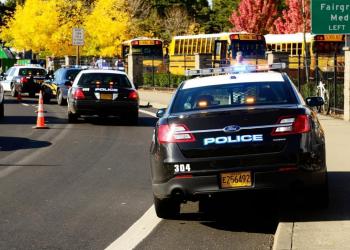
Can You Detain Non-Suspects with No Reasonable Suspicion to Believe They Are Involved in a Crime?
Generally, detaining an individual without reasonable suspicion violates the Fourth Amendment. There’s an exception, however, when the person detained is a material witness to a pending possible crime. To justify such a suspicionless detention there must be an exigency requiring immediate action, the gravity of the public interest must be great and the detention must be minimally intrusive, both in length of time and amount of force used. A threat of an imminent school shooting justifies a temporary detention of people who might know the whereabouts of the alleged shooter. Excessive force used during such a detention, however, may lead to civil liability for which there is no qualified immunity.
On March 5, 2018, Ryan Bernal, a student at the Vista Del Lago High School in Folsom, California, sent a text to a friend stating that he intended to “shoot up the school, and today was the day.” This message was apparently passed onto the Folsom Police Department. After officers determined that Ryan did not show up at school that morning, Folsom asked for help from the Sacramento County Sheriff’s Department. Seven uniformed deputies responded to Ryan’s home address. They completed a “premises history check” of the Bernal residence before arriving, allowing the deputies to determine that William and Celia Bernal (presumed to be Ryan’s parents) lived there. It was also determined that no firearms were registered at the address or in any of the Bernals’ names.
One of the deputies called the house and spoke with Celia. Identifying himself as a Sacramento County sheriff’s deputy, he informed Celia about the threats Ryan had made and asked to speak with him. Celia told the deputy that Ryan was at his grandmother’s house, but refused to tell the deputy where that was because she couldn’t verify who she was talking to. The deputies therefore drove to the Bernal residence en masse just as Celia and William were coming out of the house and heading toward their car.
The deputies made contact, intending to detain the Bernals long enough to determine Ryan’s location. Celia, agitated and yelling, again informed the deputies that Ryan was not home. Telling the deputies that she did not want to speak with them anymore, and ignoring their commands not to leave, she got into her car, started the engine (which she denied doing), and appeared to be ready to back out of the driveway.
Because she was ignoring their commands, one of the deputies blocked her from driving away by standing at the back of her car, while other deputies reached inside in an attempt to grab the keys. Two deputies grabbed her arms from both sides, applying a “twist-lock” (a type of control hold which uses pain to gain control) to her right arm. Yelling at William to use his cellphone to record what was going on, Celia eventually quit resisting. She was removed from the car and put into a plastic lawn chair, unhandcuffed.
Meanwhile, other deputies confronted the also agitated 6-foot, 3-inch, 290-pound William as he stood in front of Celia’s car. As he yelled at the deputies to stop touching Celia, William placed a duffel bag he was carrying onto the hood of the car and “aggressively” reached into it (an action he later denied doing). At that point, one of the deputies drew his firearm and pointed it at William. When William pulled a cellphone out of the bag, the deputy reholstered his weapon. Telling him to put his phone away and to calm down, two deputies (both significantly smaller than William; about 5 feet, 7 inches) struggled with a yelling, uncooperative William, attempting to handcuff him by “wrenching” his arms behind his back as they pushed his head into the hood of the car.
One of the deputies testified that William “elbow(ed)” him in the chest, necessitating the force the deputies used. William, in turn, testified that the deputies kicked his legs apart causing his knees to buckle, forcefully pushing his torso onto the hood of the car and forcing his head to turn past its natural range of motion. The deputies denied they touched his legs or knees. As they attempted to handcuff William, one of the deputies used a “rear twist-lock” while he attempted to push him onto the hood of the car. William denied resisting at all, claiming that he only tried to twist away from the deputies to relieve the pain caused from his recently surgically repaired shoulders.
Once the deputies got William handcuffed and under control, they used a second pair of handcuffs to create a “daisy chain,” allowing William’s shoulders more room. William was put into the back of a patrol car, from which he was released about 10 minutes later. This whole episode, as recorded on the deputies’ body cameras, lasted approximately 20 minutes. The Bernals then led the deputies to the grandmother’s house, where Ryan was taken into custody by Folsom P.D. officers.
Ryan pleaded no contest to a misdemeanor P.C. § 422, making threats to commit a crime resulting in death or great bodily injury, and unlawfully possessing a firearm – a charge that was later dismissed. The Bernals were apparently never charged with any offenses.
The Bernals sued the deputies and the Sacramento County Sheriff’s Department in federal court alleging, among other things, that their detentions and the force used on them violated the Fourth Amendment. The federal district court granted the deputies and sheriff’s department’s motion for summary judgment to dismiss the lawsuit, ruling that the deputies’ use of force was reasonable under the circumstances. The court also ruled that even if not, the deputies were entitled to “qualified immunity,” since there was no case law putting the deputies on notice that the force they used might have been excessive. The Bernals appealed.





